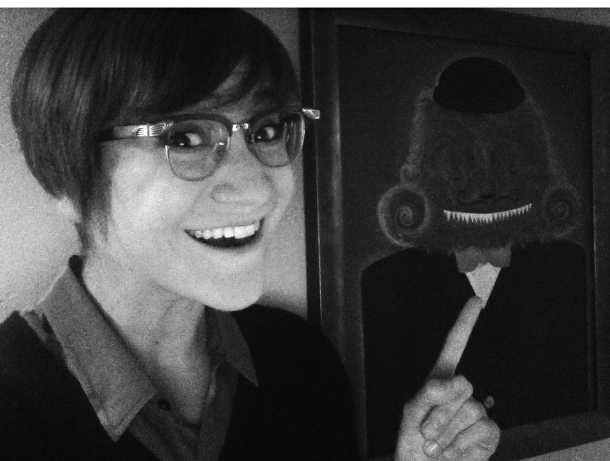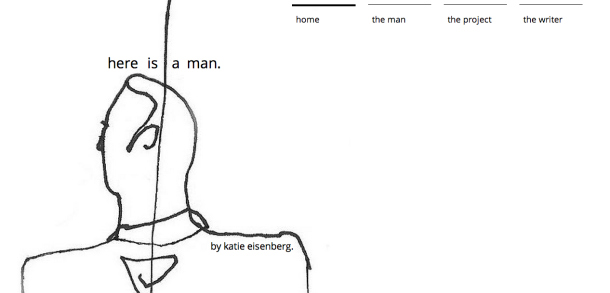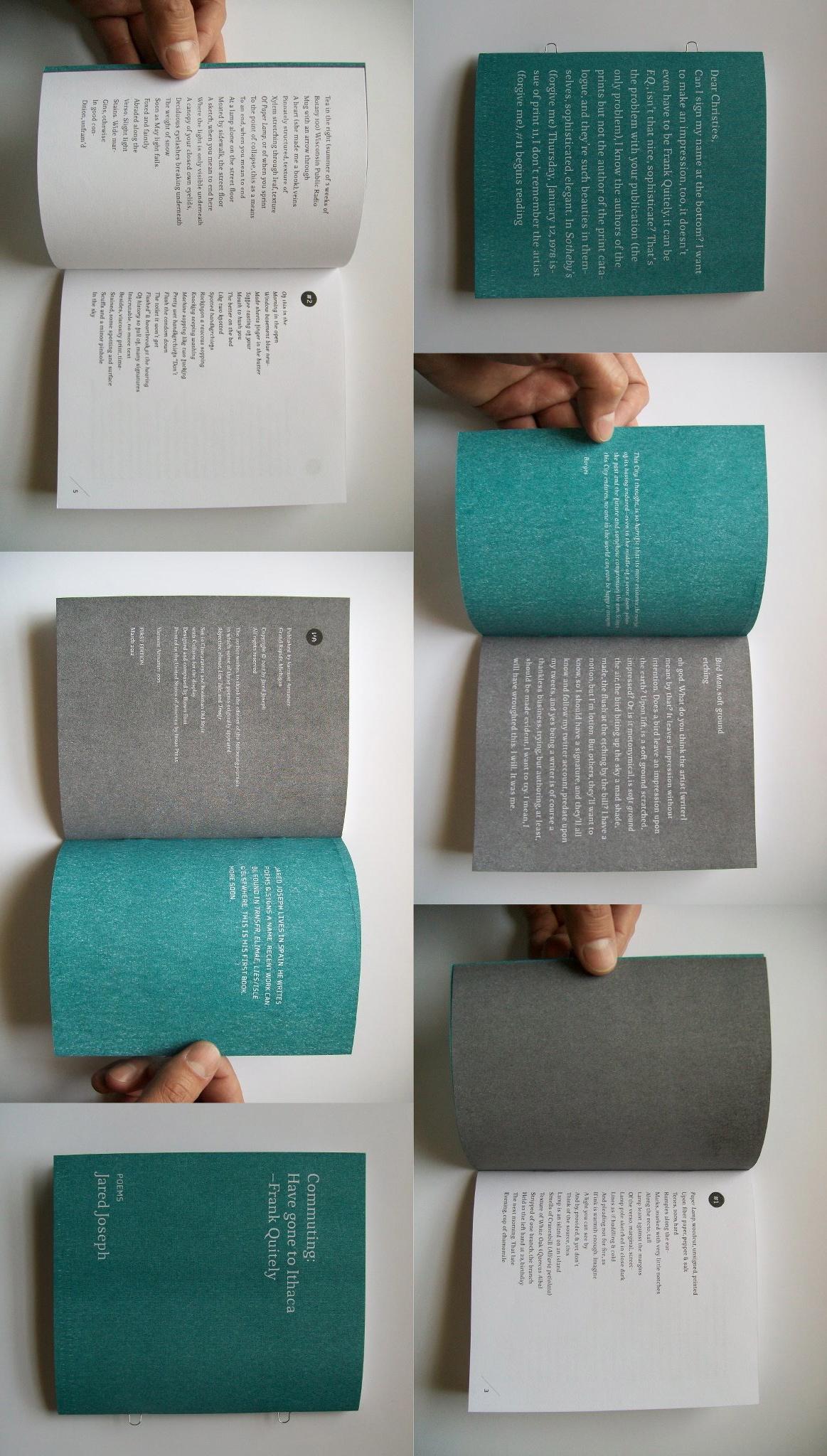A recent graduate of NYU’s Tisch School of the Arts (BFA, Drama), Katie Eisenberg is an actor, writer, and visual artist based in Los Angeles, California. Katie is the creator of the ongoing writing-turned-multimedia project Here Is A Man, and her work has previously been published by Scholastic Press. She moonlights as realtor John Swarthreppe, host of the reading series Speaking While Reading! With John Swarthreppe & Friends. You can currently see Katie in a commercial for Braun electric razors, which, sadly, she doesn’t use. To learn more: www.katie-eisenberg.com.
***
UFR: Your list of artistic talents and achievements seems to be endless: visual artist, actor, director, writer, musician, voice artist, certified clown, cartoonist, balloon artist, snail mail writer, etc. How does each part of your creative process inform your other projects? Do you have a favorite type of artistic expression (or whatever you’d like to call it)? What draws you, personally, toward creation?
Eisenberg: There are tons of ways that you can attempt to make sense of the world around you. You can also elect not to make sense of it at all, which is perfectly fine, but a little bit lazy. My method of choice for sense-making is creation, especially because I’m such a process-oriented person rather than a product-oriented person. I’m a little infamous for generating massive amounts of stuff (especially writing) at warp speed, so, naturally, a ton of it ends up never seeing the light of day (because it’s really, really bad). But anything I create is really just my way of saying, “Hey, I’m trying to figure this whole world out, maybe if I put this here and that there it will illuminate things a little bit.”
Sometimes creating stuff won’t illuminate things. Sometimes it will make everything that much more complicated. But that’s a risk you have to be willing to take.
I’ll add that I’m an intensely private and solitary person and a keen observer of people. I feel very uncomfortable at parties that are larger than “small get-togethers with a few friends.” All of this makes me pretty well-equipped to spend a lot of time creating things.
I’m fun, though. I promise that I’m fun, everybody.
UFR: I want to ask you about Here Is A Man. Can you briefly summarize the project?
Eisenberg: Here Is A Man consists of three parts: the written part, the audio part, and the performance part. The written part is the core of it, which makes sense, because it started out as just writing – these little bite-sized, non-linear installments of fiction about a man. Now, it is broken down into Part One, thirty “chapters” which highlight different events in the life of this man from age 22 to age 67 (in no particular order), and Part Two, which I’m currently writing. Part Two is a linear storyline, an expansion on a specific incident that happens when the man is 42 years old – it’s the first time we really see what consequences his actions have, because Part One is mostly about how he just does stuff and moves on. The audio component consists of original narrations of each entry (being added, slowly but surely) by some amazingly talented folks. It’s a grand-scale collaboration across coasts (most of the narrators don’t live in LA), which really excites me. On the website, I describe it as a “living, breathing, ever-expanding archive of voices, compiled in the pursuit of understanding how we turn a man into a myth and turn that myth back into a man.” I guess archive is a pretty good word for the project, as a whole. Installation is also a pretty good word for it. And so, I keep writing. People keep narrating. There are now some super nifty illustrations provided by a very talented man named Zach Webber. And there’s an experimental performance stage of it in the works, which has garnered the attention of contemporary art spaces like REDCAT and Irrational Exhibits. More on that as it develops.
UFR: Who is the man? Is he an everyman, a nowhere man, a non-representative “just a man” man? All of the above? None of the above? Is he just (by which I mean, does he just exist)? Where did he come from? Where do you think he’s going? (Where would you like him to go, if that’s different from where you think he’s headed?)
Eisenberg: When I first started writing about this man – whose name, while rarely mentioned, is Jack – I was very aware that I was writing about myself. It was really an exercise in filtering some incidents in my life through the lens of this middle-aged man who doesn’t function according to normal social cues. Since then, he has (thankfully) evolved into his own person. We still have a lot in common, as can probably be said of any writer and his characters. But it became pretty clear that he and I are not one in the same. This is a little bit frightening, but only because it makes me feel like I have less control over him. I’m sure a lot of people would say, “Well, Katie, of course you have control, you’re the writer,” But I’m not so sure that it works like that.
A very wise friend of mine described the man like this: he’s someone who has all of these crazy big intellectual ideas but he doesn’t know what to do with them. Basically, he doesn’t comprehend action so well. So his life seems a little bit useless.
Another very wise friend of mine (I have a lot of very wise friends) described an earlier project of mine like this: “it functioned on an impeccable logic even though it was absurd.” I’ve realized that this is kind of a hallmark of a lot of the work I create, and I think it describes the man of Here Is A Man pretty darn well.
UFR: You’re originally from New York, but you recently made the move to Los Angeles. What about each city (or each coast) attracts you? What repels you? What is the strangest or most fascinating thing about each? Which atmosphere, do you feel, best fosters your particular creative process? If each does, why do you think that is? What do you find yourself doing more when you’re in L.A.? New York?
Eisenberg: I’ve been living in LA for about five months now, and here’s what I’ve found: LA and New York are both really weird cities filled with really weird people. LA often reminds me of the Island Of Misfit Toys, which one wouldn’t necessarily expect. It’s pretty endearing. It also generally feels like it’s in a bit of a timeless time warp, on multiple levels. On a contemporary, day-to-day level, it feels that way because the weather here is, on, the whole, unchanging, so the days seem to blur together. On a more historical level, there is this immense sense of nostalgia built into the environment here, but it isn’t a new thing – as in, it isn’t this current nostalgia for the past. It’s like the nostalgia existed as the city was being built. Nostalgia before the fact. LA is also a massive sprawl, which means that there’s a lot of variation from neighborhood to neighborhood. The architecture here is bizarre and incredible. The vegetation is ridiculous. There are palm trees and succulents and birds of paradise and Italian firs happily living side by side. The city is made of contradictions. But I like that.
There’s a huge misconception about LA, which is this: it doesn’t have “culture.” Or “art.” A ton of people (especially New Yorkers) seem harbor this opinion. It’s what I thought, too, before moving here. But there’s so much culture! There’s so much art! And there’s actually a fantastic climate for making new work here! One of my huge problems with New York is that it is almost oversaturated with new art. Sometimes it ends up feeling like a wash. This isn’t to say that I object to everybody making stuff. They should keep doing it. But to everyone who claims that LA doesn’t have that sort of thing going on, I highly recommend that you pay a visit and check it out for yourself. LA has been absolutely incredible for my own creative process. I’m almost certain that Here Is A Man wouldn’t have become what it now is had I not moved here. My parents live in New York, but my dad is a huge fan of California, and every single time we talk he says something to the effect of, “California really is a remarkable place for innovators.” And I agree with that, and not just because, at the end of the day what I’d like to call myself is an “innovator.” LA always seems to be saying, “Hey, I’ll be whatever you want me to be, baby!” It’s so malleable. Whereas New York, in my experience, is very much about the city asserting its own identity, in a “I will shape you, my inhabitants,not the other way around!” sort of way. Obviously, these are just my opinions. Of course people always shape places and places always shape people.
LA is marvelously inspiring. It isn’t inspiring in the same way that, say, New York is inspiring, or Big Sur is inspiring. It’s not romantic, in my experience. Then again, I’m not a terribly romantic person, so I’m probably not looking hard enough.
What have I not mentioned? Oh yes. Cars. Driving. I am lucky enough to live in one of the more walkable areas in LA. Which is great, because, as someone from New York, I have a really hard time not walking everywhere. So, yes, I drive when I have to (which is pretty often), but I also walk all the damn time. And so few people walk like that here. But I can’t seem to get it out of my system. I think New York will always be under my skin like that.
I’ll close with this: I love LA. It’s my home. It took me in for exactly what I was and it hasn’t tried to change me, which was the nicest sort of surprise. I love New York, too, but, if need be, I will defend LA like my life depends on it.
UFR: You have a pretty unique relationship with UFR — you’re one of our earliest contributors, are a columnist, and Winston, our mascot of sorts, is one of your original paintings. Can you talk a little about your relationship with visual arts? (What is Winston, by the way? Where is he now?)
Eisenberg: The visual arts were my first real love. I can distinctly remember a large portion of my life when I stopped engaging in drawing and painting, and then, in college, I started getting back into it and it was like finding an old favorite sweater in the back of my closet. People started to commission me for projects ranging from promotional artwork to logo design to website design, and I now do work in that vein pretty frequently – it’s one of my primary sources of income, which is kind of a dream come true.
Winston is a painfully polite Bigfoot-Wookie hybrid. He was painted over the course of the summer of 2010 at a kitchen table in an NYU dorm. Right now, he hangs above my bed.
UFR: You’ve said before that you find yourself frequently writing about men and frequently drawing women, but rarely the opposite. Why do you think this is?
Eisenberg: I haven’t written anything with a female protagonist or narrator since I was 14 years old (I spent many hours sorting through a lot of really old, really bad writing of mine in order to figure this out). I think that I prefer to write about men primarily because of my own gender-queer-ness, which is to say: I’m a biological female who identifies more as a male. I view myself as a feminine boy, which is also how I would describe most of my male characters.
UFR: One of your more recent theatrical projects, Antics!, was a pantomime/dance piece. What is your relationship to text in terms of performance? Do you think most things are better “said” (/expressed) when words are absent?
Eisenberg: Antics! was my final project before I graduated from NYU’s Experimental Theatre Wing. Over the course of six months, I had written many, many potential projects. Most of them were musicals. One was an opera. But as the time to start the rehearsal process neared, I began to feel absolutely suffocated by words. It was the first time I had ever really felt that way before, because words are my comfort zone. Suddenly, it seemed like they weren’t enough. So I decided to stray from my usual work pattern and live in a realm of images. I sorted through every potential project I had written and pulled out the images I loved from each of them (unsurprisingly, some of the same images occurred in multiple projects). I threw story out the window, and I think I remember telling the cast, at our first gathering, that “if a story emerges, awesome! And if not, that’s okay, too.” And then we made some stuff happen. And a story did emerge. It was one of the most incredible experiences I’ve ever had, and afterwards I remember thinking “OH MAN I WILL NEVER GO BACK TO WRITING AGAIN!” Which, you know, didn’t really happen. I did go back to writing. But it was a fun thought. I just think that words and I needed a break. Sometimes you need to leave what you know in order to return to it.
UFR: How do you approach solo work vs. collaborative work? Do you prefer one method over another?
Eisenberg: As I mentioned earlier, I’m a very private person. My writing process is a solitary sort of endeavor. However, I also love being a part of ensemble-generated work, and I really, really love saying “yes” to people when they come to me with ideas for their own projects. Yes as in, “Yes, that’s possible! Yes, let’s do it! Yes, what do you need from me, I’ll make it happen!” “Yes” in a way that is totally free of false support or ego-cushioning, because I don’t tolerate mediocrity in my own work or anyone else’s.
In an “is-it-selfish-or-is-it-sort-of-generous-or-maybe-it’s-both” sort of way, my favorite role to play in the generation of collaborative work is to be the one responsible for gathering all of these amazing, brilliant people together. Like Kermit the Frog, if that makes sense. Have you heard Kermit play the banjo? He’s great. But he really shines when he’s encouraging the Muppets to come together and work as a unit. So, at the end of the day, I’d like to be a Kermit.
Here Is A Man has evolved from being written to being written and read, and you hope (?) to turn it into a performance piece in the future. A very general question: what do you see as the relationship between text and voice?
I’m fascinated by the inherently performative capacities of non-dramatic literature. Basically, reading aloud. Text, when read aloud, is endowed with such magic! When it comes to Here Is A Man, it’s always terribly exciting to hear the narrations people send in, because I know precisely how these chapters sounds in my head, and, of course, they never sound that way when anyone else reads them. My affinity for reading aloud is actually what drove me to create Speaking While Reading!” with John Swarthreppe & Friends, which is the only reading series hosted by a (fictional) real estate agency. We have our first reading coming up on December 9th at this wonderful bookstore called Stories, in the Echo Park area of LA. I’m terribly excited about it.
UFR: Besides Here Is A Man and Speaking While Reading, what’s next for you, on the project front?
Eisenberg: I have two musicals in the works (who knows, they might become one musical, by the end of it) – one is about the collaboration between two gay mad scientists, and the other is about the lives of Nikola Tesla and Oscar Wilde.
UFR: Who do you read for inspiration? For pleasure? For guilty pleasure? For return visits?
Eisenberg: I won’t specify which of these fall into which of the categories you mentioned. You might be able to guess, though. Kurt Vonnegut, David Sedaris, Steve Martin, Roald Dahl, Truman Capote, Fran Lebowitz, Jim Henson, Oscar Wilde, Ernest Hemingway, The New Yorker, The Hollywood Reporter, and the final page of the NY Times Magazine every Sunday.
Here is a specific book: Like Shaking Hands With God: A Conversation About Writing, by Kurt Vonnegut and Lee Stringer. Anyone and everyone who has ever written or writes or will write should read this. It’s short. It’s great. Please just read it.
UFR: Do you have a nightstand? What do you keep on it?
Eisenberg: Yes, I do. This is what is on it:
- An Edison-style lamp. It looks like a clear glass cylinder with a light bulb in it. On a wooden base. If I were a lamp, I think I’d look like this.
- A frightfully high pile of books. I am always halfway through all of them.
- A wristwatch I never wear.
- A headlamp, for nighttime reading.
- A small stack of photos of various people I like.
- My glasses, if I’m sleeping.
UFR: You also have a bit of a background in marine biology. Favorite sea creature? Favorite land mammal?
Eisenberg: Sea creature: lobster. Land mammal: skunk. Hold on, can I add an insect? Walking stick bugs.
UFR: What very “boring” part of your daily routine (if you have one) do you love the most?
Eisenberg: I do have a daily routine, and most of it is very, very boring. My favorite part involves eating high fiber cereal for breakfast. It’s literally (and I don’t use that word casually) what I get unreasonably excited about every morning when I wake up.
UFR: Do you ever catch yourself dancing? When? To what?
Eisenberg: All the time. It’s usually to David Bowie.
***
This interview was conducted by Susannah Lawrence (Managing Editor), who currently lives, breathes, works, studies, tweets, copyedits, and interns in New York City.





